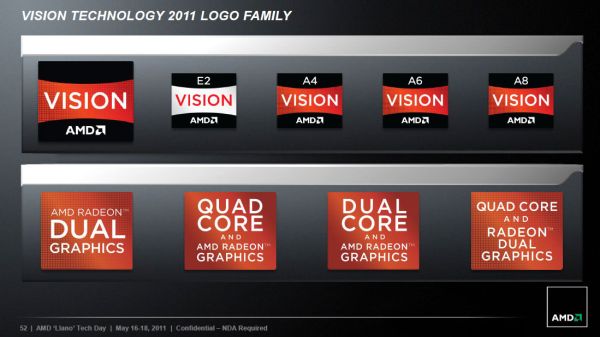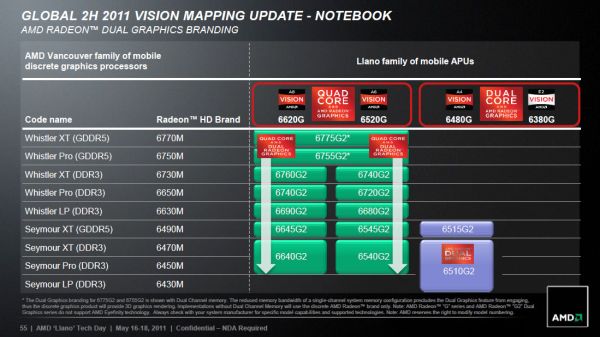The AMD Llano Notebook Review: Competing in the Mobile Market
by Jarred Walton & Anand Lal Shimpi on June 14, 2011 12:01 AM ESTIntroducing Mobile Llano
Anand has provided our coverage of Llano’s architecture and he’ll have a preview of desktop performance, but he’s leaving the mobile coverage to me (Jarred). At a high level, the breakdown of Llano is really quite simple: take a K10.5 series CPU core (dual- or quad-core), pair it up with a DX11 capable GPU core similar to AMD’s Redwood line (5600/5600M or 6500M), and then mix in power gating and Turbo Core; bake everything in a 32nm process and you’ve got Llano. Easier said than done, of course, as K10.5 parts previously used a 45nm process while Redwood used 40nm, so AMD had plenty of work to do before they could realize the simplistic overview I just described; the result is what matters, though, so let’s break out our spoons and see how the pudding tastes. Here’s the overview of the mobile A-series APUs launching today.
| AMD A-Series Fusion APUs for Notebooks | |||||||
| APU Model | A8-3530MX | A8-3510MX | A8-3500M | A6-3410MX | A6-3400M | A4-3310MX | A4-3300M |
| CPU Cores | 4 | 4 | 4 | 4 | 4 | 2 | 2 |
| CPU Clock (Base/Max) | 1.9/2.6GHz | 1.8/2.5GHz | 1.5/2.4GHz | 1.6/2.3GHz | 1.4/2.3GHz | 2.1/2.5GHz | 1.9/2.5GHz |
| L2 Cache (MB) | 4 | 4 | 4 | 4 | 4 | 2 | 2 |
| Radeon Model | HD 6620G | HD 6620G | HD 6620G | HD 6520G | HD 6520G | HD 6480G | HD 6480G |
| Radeon Cores | 400 | 400 | 400 | 320 | 320 | 240 | 240 |
| GPU Clock (MHz) | 444 | 444 | 444 | 400 | 400 | 444 | 444 |
| TDP | 45W | 45W | 35W | 45W | 35W | 45W | 35W |
| Max DDR3 Speed |
DDR3- 1600 DDR3L- 1333 |
DDR3- 1600 DDR3L- 1333 |
DDR3- 1333 DDR3L- 1333 |
DDR3- 1600 DDR3L- 1333 |
DDR3- 1333 DDR3L- 1333 |
DDR3- 1333 DDR3L- 1333 |
DDR3- 1333 DDR3L- 1333 |
There are two different power envelopes for Llano right now: 35W and 45W. The former models end with an M while the latter end in MX. Don’t let the relatively high TDPs fool you, as similar to Intel we’re looking at maximum TDP while idle and low-load TDP will be far lower. Based on battery life, it appears that the entire test notebook consumes around 7.42W at idle. By comparison, a slightly larger dual-core SNB notebook consumes around 7.68W when idle, so we’re very close to parity at idle. As noted earlier, all APU models come with 1MB L2 cache per core, and Turbo Core allows for cores to clock up to higher values under the right circumstances. That could prove important, as clock-for-clock K10.5 cores can’t hope to keep up with Sandy Bridge, and Sandy Bridge parts are already clocking significantly higher.
On the CPU side of the equation, there are currently only dual-core and quad-core parts, so tri-core appears dead (or at least MIA for now). The other part of the APU is the GPU cores, and here there are three options. The A6 and A8 APUs are both quad-core, but A6 has 320 Radeon cores clocked at 400MHz compared to 400 cores at 444MHz—so the 6620G is potentially 40% faster. A4 APUs trim the GPU further, with 240 cores clocked at 444MHz, and they’re the dual-core parts. The 6620G could be up to 67% faster than 6480G, under the right circumstances. As Anand mentioned, right now all of the A-series APUs are coming from the “big Llano” die, but in the future we’ll see the A4 production shift to “little Llano” instead of using harvested die.
Vision and Radeon Branding
For 2011, AMD is simplifying their Vision branding with Llano, skipping the Premium, Ultimate, and Black modifiers and instead referring to the APU. Vision E2 refers to the dual-core E-series APUs, while the A4, A6, and A8 lines correlate directly with the A-series APUs. The Radeon brand continues as an important asset, so there will be sticker options to promote quad-core and dual-core CPUs with Radeon graphics. What about the Dual Graphics, though?
With the integrated GPU finally able to approach the performance of midrange mobile GPUs, AMD is making a return to hybrid CrossFire (IGP and a dGPU working together), though the official name is now apparently “Radeon Dual Graphics” or just "Dual Graphics"; we’ve also heard it referred to as “Asymmetrical CrossFire”, and we’ll use any of these terms throughout this article.
We first saw an attempt at hybrid CrossFire with the HD 2400 and the 790 chipset, and later that extended to HD 3400 cards, but it never really impressed as it was limited to desktops and you could still get far better performance by spending an extra $10 to upgrade from a 3400 to a 3600 dGPU. The 6620G fGPU is several times more powerful than the old HD 4250 IGP, making CrossFire potential useful, especially on laptops where the power savings from shutting off the dGPU are very significant.
With Radeon Dual Graphics, AMD introduces more brands. The various Fusion GPUs (fGPUs) only work in CrossFire with specific discrete GPUs (dGPUs)—nearly all of the 6400M, 6600M, and 6700M line are eligible—giving rise to several new Radeon names. If you start with a base of a Radeon HD 6620G and add a Radeon HD 6770M to it, the resulting combination is now called a Radeon HD 6775G2. Pair it with a 6750M and you get a 6755G2. The entirety of the list is depicted in the slide from above. For now these names are just going to be listed on the notebook spec sheet, the drivers themselves will report the actual GPU you have driving the panel you're connected to. AMD is still working out the right way to expose these names through software to avoid confusion.












177 Comments
View All Comments
JarredWalton - Tuesday, June 14, 2011 - link
Civ5 and TWS2 are both tested with the latest drivers. The K53E was also tested with drivers that are at most a couple months old. Intel current lists the latest laptop drivers as 15.22.1.64.2361 from 4/13/2011, which is what I'm running on the Intel units right now. If there are some newer drivers that I'm missing out on, let me know and I'll go try them.duploxxx - Tuesday, June 14, 2011 - link
Nice review, it seems like there is a lot of work on CF.Actually I reviewed the Liano already months ago, I mentioned in the last mobile reviews that it will be better performing then the Toshiba with the P920 with really good battery performance. So it is a win -win for the budget line anyhow. Top line remains intel for the CPU power.
Regarding the quote:
Now if you want to have your cake and eat it too, the APU to wait for would be Trinity. Due out somewhere in the 2012 - 2013 timeframe, combine a Bulldozer derived architecture with AMD's next-generation GPU architecture and you've got Trinity.
Trinity will not only be an improved GPU it also has the BD core inthere which will offer much more punch. THe reason LIano is late is because of the 32NM process. It could have been released much sooner. Sure they took an outdated K10 and that is the main issue together with the not enough aggressive Turbo for single thread, they should have adapted this more aka BD.
But assumin Trinity is a rather late 2012 project (by stating 2012-2013) you are way way off...
ET - Tuesday, June 14, 2011 - link
Quote probably reflects an increase in pessimism due to recent events. Bulldozer is still not out, and AMD is said to have had a hard time getting clocks up. So sure, we're all hoping to see Trinity early in 2012, but anyone setting their expectations a little farther are less likely to be disappointed.duploxxx - Wednesday, June 15, 2011 - link
didn't i mentioned it would be launch faster then expected?http://www.cpuforever.com/showthread.php?tid=1574&...
the delay of Zambezi BD has nothing to do with real architecture issues.....
ET - Wednesday, June 15, 2011 - link
That's not the sites which posted on it, including Anandtech, said based on what AMD said (that is, that Bulldozer was not up to speed).Jamahl - Tuesday, June 14, 2011 - link
Was that really needed? I mean...really? Who the hell would do that and for what reason?ET - Tuesday, June 14, 2011 - link
I already got my E-350 laptop, but as Jarred says, Brazos just became less interesting. I'll be waiting to see what price point and performance the dual core Llano will have. What impressed me most was battery life, which is competitive with the E-350 laptop, and it'd be interesting to see how small and light Llano laptops will get.The other takeaway I have from this is that as usual I'm impressed at how far Intel has gone with its integrated graphics. Sure Llano gives it a good beating, but that's at the expense of a lot more die space. I imagine that Intel will continue to tweak its 3D cores and I can't wait to see how this race will develop.
Anosh - Tuesday, June 14, 2011 - link
What happened to power consumption?!Some of us get laptops due to the optimization in the power department over similar desktop parts!
JarredWalton - Tuesday, June 14, 2011 - link
Power = [Battery Capacity] / .98 [efficiency] / ([Battery life in minutes] / 60)So if you take the battery life charts, you can determine roughly what the total system power draw is using the above. Or you can look at the "Relative Battery Life" charts and get the same information as Minutes/Wh instead of converting into Watts.
jabber - Tuesday, June 14, 2011 - link
In my work I get a lot of laptops to fix. If there is one game or genre that appears on 80% or more of them its......The Sims.
I also get asked a lot "if I buy this laptop will it play The Sims?"
Never ever been asked if a laptop will play Crysis or any of the games you use.
Just saying.